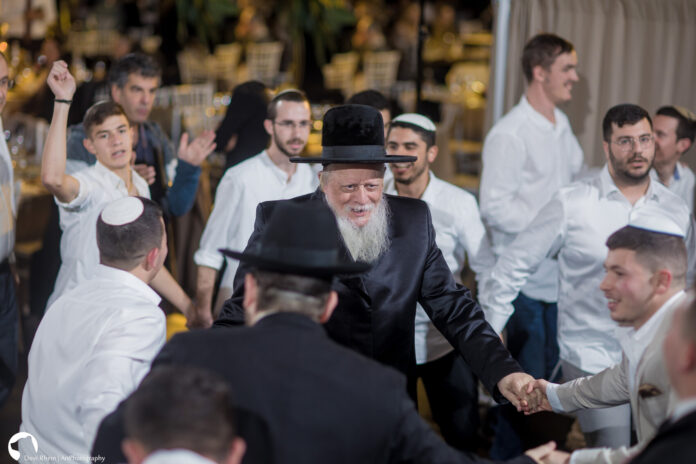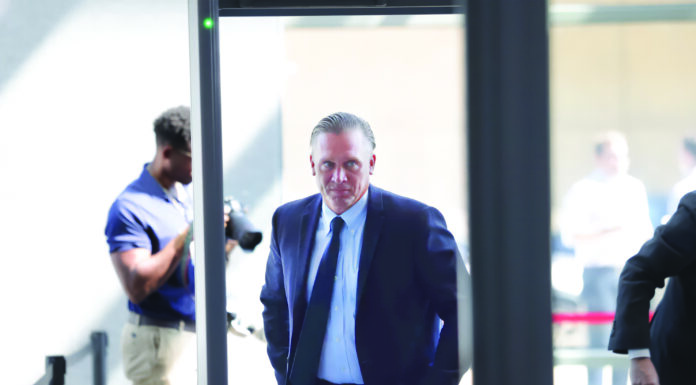I still remember when we first came here in 1984. It was almost empty, a spiritual and physical wasteland. There were only some rocky hills, a forest and a cluster of buildings as the beginning of a neighborhood that was starting to take shape. It didn’t even have a shul or beis midrash. Today it’s home to tens of thousands of residents and has dozens of shuls, yeshivos and educational institutions for people of all ages. Our dream is to continue to build on what we’ve already achieved to perpetuate and glorify the Torah.”
We are guests in the home of Rav Mayer Alter Halevi Horowitz, the Bostoner Rebbe, on the outskirts of Har Nof. We are right near Givat Pinchas, the shul and chasidic complex named after the founder of the chasidus.
The windows of the house offer views of the Yerushalayim Forest and the small settlements that dot the road to Yerushalayim. Har Nof is huge, one of the biggest chareidi neighborhoods in Yerushalayim and home to many of its greatest rabbanim. It was Rav Levi Yitzchok Horowitz of Boston, zt”l, who had the foresight and vision to clear the way and establish this place as the court of the Bostoner chasidic dynasty. His son, Rav Mayer Alter Horowitz, is now following in his footsteps, having helped him plant a stake in Yerushalayim in those early pioneering days and develop the mosdos.
A legacy of learning
The current Bostoner Rebbe is a scion of the Horowitz family, descended from the Shelah Hakadosh and Rav Shmuel Shmelke of Nikolsburg, who was a talmid of the Maggid of Mezeritch. In fact, the Baal Shem Tov said of Rav Shmuel Shmelke’s family, “They are the most meyuchasdik family, a direct succession, son after son, from the Shelah Hakadosh.”
“There were two brothers, Rav Shmuel Shmelke and Rav Pinchas, who was known as the Baal Haflaah,” the Rebbe explains. “The Baal Haflaah said that his brother, Rav Shmuel Shmelke, was greater than he was, but in contemporary times the Baal Haflaah is better known because his sefer was one of the first scholarly volumes to use the yeshivishe method of studying the Gemara that is now prevalent. Rav Shmuel Shmelke, by contrast, employed the pilpul method, which has fallen out of favor. But the Litvishe approach predates the Baal Haflaah, who based it on precedent. Our approach is that everything that is learned or transmitted to others must have a source. The Chasam Sofer said that when one says things that have no source, it isn’t considered chochmah.”
From Yerushalayim to Boston
Interestingly, Bostoner chasidism originated in the Old City of Yerushalayim; that is where its founder, Rav Pinchas Dovid Horowitz, was from. Not only was he a descendant of the prestigious Horowitz family, but his mother was descended from the court of Lelov, the first chasidic court in Yerushalayim.
When Rav Pinchas Dovid was a young man whose leadership abilities were already apparent, his uncle, Rav Dovid’l of Lelov, asked him to travel overseas to the spiritual wasteland of America. Rav Dovid’l knew that his nephew would be able to fan the flames of whatever Yiddishkeit was to be found there and exert a positive influence. But despite his uncle’s entreaty, he didn’t want to go to America and remained in Eretz Yisrael.
Over a decade later, a dispute arose among the various kollelim of Yerushalayim. The Jews of Yerushalayim under Turkish rule were poor and downtrodden, subsisting on meager portions of bread and water. They relied on donations from their home countries. For example, Kollel Chibas Yerushalayim was for Jews from Galicia, and Kollel Shomrei Hachomos was for Hungarians. These kollelim would dispatch meshulachim, collectors, to their countries of origin to collect money for their compatriots in the Holy Land. The roshei kollel would distribute the money to those who were on their registries.
There was once a disagreement about how to divide these monies, so it was decided to send a delegation of Jews from Yerushalayim to Galicia to attend a special conclave on the subject. Among the delegates was Rav Pinchas Dovid, who went to Galicia and took part in the historic din Torah there. Afterward, he remained in Poland and visited some of its gedolim. He was about to return home when World War I broke out and he found himself trapped.
“My grandfather made it as far as Salonika, which was part of the Ottoman Empire and had a large Jewish population,” the Rebbe recalls. “But it was simply too dangerous to travel any further. The ports in Eretz Yisrael were closed, and there was nowhere to go. One of the only neutral countries he could go to was America. Remembering his uncle’s request, he left for the United States.”
When Rav Pinchas Dovid reached America, the Jews of Boston asked him to settle in their community, and he agreed. He moved into a house on Barton Street in the West End and planted the first seeds of chasidus in the city.
“My grandfather didn’t want an official position or any honors for himself,” says Rav Mayer Alter. “When someone gave him a kvittel or asked for guidance, he would emphasize that they shouldn’t expect much from an ‘American rabbi’ who was ‘a simple Jew.’ He always wanted to return to Eretz Yisrael, which by then was under the British Mandate. When he finally went to board the ship that would take him home, he was accompanied by 500 cars filled with admirers who wanted to see him off at the pier.
“Back in Eretz Yisrael, he purchased some land in the Shuafat neighborhood of Yerushalayim, now known as Ramat Shlomo, to establish a chasidic community. But then came the Great Depression, which greatly affected the Jews in Eretz Yisrael because donations from America dropped. When many wealthy American Jews lost their fortunes and went bankrupt, the Jews of Yerushalayim were left with little to eat, and community development came to a halt. Back then, even a few dollars could go very far in supporting a family, but it was difficult to obtain even that much.
“At that point, my grandfather returned to Boston with his family, but they eventually relocated to Williamsburg in Brooklyn. My father, Rav Levi Yitzchok, zt”l, then moved to Boston to rebuild the remnants of the Bostoner community at their request. That’s where I was born and grew up.”
“Where did you go to school?” I ask.
“My brother and I were sent to a local kindergarten and cheder. It was mixed, with boys and girls learning together. We learned one pasuk a week because we didn’t know Lashon Kodesh. At the age of nine, my brother was sent to New York so he could attend Torah Vodaas, where he stayed in a dormitory. I was also sent there when I turned nine, and we dormed together in the same room. After Torah Vodaas, I studied for a while in Ponevezh.”
“What kind of kehillah existed in Boston in those days?”
“It was a small but cohesive community. It was also home to some of the greats of that generation, including Rav Mordechai Savitzky, zt”l, a Polish-born gaon who authored 22 sefarim on Talmud Bavli and Yerushalmi. His first volume, Bikkurei Mordechai, was published when he was only 19 years old. He was close to the kana’im, and for a while he was considered a candidate to lead the chareidi community in Yerushalayim. In Boston, however, he had no official position because he wasn’t fluent in English.
“After his wife passed away, he decided to return to Poland, but World War II broke out only a few days before he was supposed to depart, and he ended up staying with us in Boston. Today his son Rav Yosef is the rosh yeshivah of Torah Vodaas.
“Boston, of course, was also the home of Rav Yosef Dov Soloveitchik, zt”l, the rosh yeshivah of RIETS, the rabbinical seminary of Yeshiva University. Rav Yoshe Ber was officially considered the rav of the city. He was very respectful of my father, and they had a good relationship. He used to sell his chametz to my father and trusted him in all matters of kashrus.
“During that time, I remember that the Reform movement was growing in influence. As a countermeasure, it was decided to establish a beis din composed of my father, Rav Yosef Dov and Rav Savitzky. It was an unusual trio: my father, a chasidic rabbi; Rav Savitzky, a kana’i; and Rav Yoshe Ber, a representative of the general Orthodox community. This was actually a foreshadowing of what we would go on to establish in Har Nof, as there we were also home to three great luminaries from different backgrounds: my late father, the rav of the chasidishe community; l’havdil bein chaim l’chaim, Rav Moshe Sternbuch, the raavad of the Eidah Hachareidis; and Rav Ovadia Yosef, zt”l.
To read more, subscribe to Ami





















